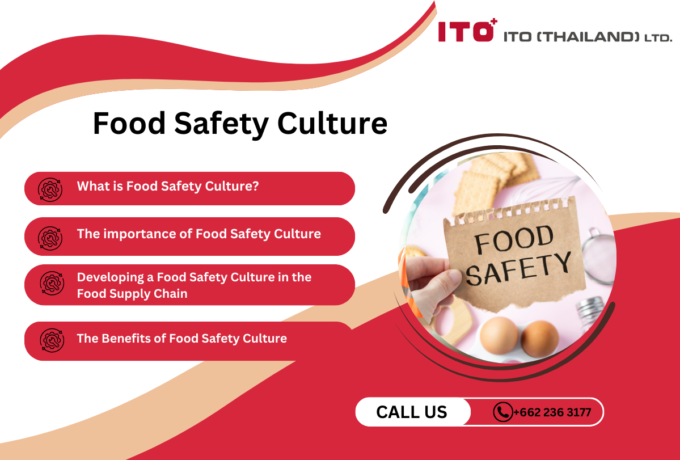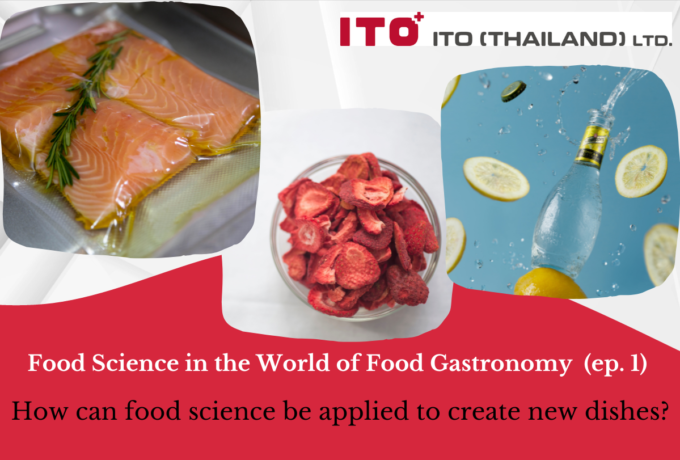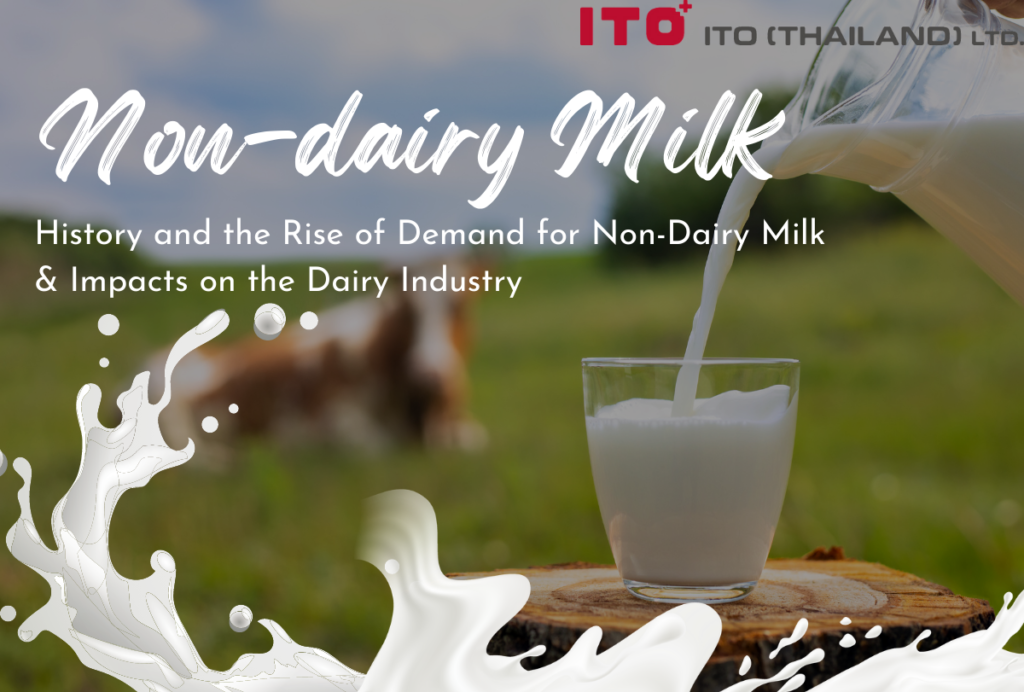ITO Thailand Hygiene Blog
Non-dairy Milk
Milk, cheese, and yoghurt are dairy products which are rich in nutrients, numerous vitamins, and minerals such as proteins, calcium, iodine, vitamin A, D, and much more (9). Lactose is among these beneficial components, which can be broken down by an enzyme called lactase into simpler sugars, glucose and galactose (10), however, some people’s bodies are not able to produce lactase as much as normal people, so they cannot tolerate lactose in milk, causing lactose intolerance with symptoms such as abdominal pain or swelling, diarrhoea, or flatulence (5).
So, food scientists have come up with a solution called non-dairy milk. They are known by several names such as plant-based milk, or dairy alternatives with some products such as soy milk, almond milk, rice milk or oat milk (Univar Solutions, 2023). In this blog, history and rise of demand for non-dairy milk, the impacts on the dairy industry, manufacturing processes, pros, and cons will be discussed.
History and the Rise of Demand for Non-Dairy Milk
Some non-dairy milk has been around for a long time, but we can say soy milk is the oldest non-dairy milk, as it has been mentioned in Chinese text from 1365 (16). Its popularity increased during the 19th century when soymilk products were widely available throughout Europe, the United States, Asia, and Australia as the most popular non-dairy milk.
As previously mentioned, non-dairy milk is usually used as milk alternatives for people with lactose intolerance, which is most prevalent for East Asian (Astoundingly, it is reported that 70-100% of people are lactose intolerant) (12). Thus, the demand for non-dairy milk has drastically increased. Moreover, vegan diet, and concerns in animal welfare are driving the demand for non-dairy milk as well (6).
Impacts on the Dairy Industry (15)
Non-dairy milk has now taken 10% of the overall milk market. A few trends have been identified as answers to why consumers are shifting away from dairy to non-dairy milk such as interests in new savour, as plant-based milks have a distinctive flavour, concerns in animal welfare, as well as minimal impacts on the environment. It is expected that it will continue to grow over the next few years.
How is it made? (Manufacturing Processes) (8, 14)
Different raw materials (E.g., nut, legume, seed, coconut) have different manufacturing processes. However, the main processes are similar. First, raw materials are soaked for up to 12 hours, then they are grinded to a specified size or blended into puree. In some cases, stabilising or thickening agents are added as well because the product is required to maintain its consistency throughout the manufacturing process.
Either thermal or non-thermal technologies such as high-pressure processing, pulsed electric field, UV radiation, ultrasound, microwave or ohmic heating can be used to sterilise, reduce the number of harmful bacteria to maintain a safe product throughout its shelf-life (1). Moreover, many beneficial features of these innovative processing technologies have been perceived such as the promotion of homogeneity and stability as a result of colloidal particle size reduction by high-pressure processing (2), reduction of microbial load by the development of pores in cell structure with a high electric current flow and low temperature of pulsed electric field (1).
In addition, in order to lessen microbial load and enzymatic activities which impact the food sensory properties, and leads to safety and quality deterioration, as well as unpreferred spoilage, so pasteurisation is the main focus of manufacturing process as it is relatable to food safety and quality (13).
Pros and Cons of Non-dairy Milk
As of now, assorted selection of non-dairy milks is available in the market, providing scores of options for consumers. When compared with cow’s milk, non-dairy milk has a higher amount of calcium and vitamin D, lower calories per serving, wider range of flavours which make them flexible to create new recipes for products such as ice cream, milk coffee, and finally, 3 times less greenhouse gas emissions (11). As discussed, non-dairy is a great choice for lactose intolerant people, as lactose is not present in these products, thus will not cause any gastrointestinal inconvenience after consumption (4).
On the other hand, non-dairy milk usually more expensive than dairy milk (7), lower protein content, not clean label packaging (contain unpreferable ingredients by consumers) as it often contains additives such as thickening agents and sweeteners (11), and some non-dairy milk may trigger allergic reaction as well, for instance, almond milk may pose tree nuts allergies (3).
It is important to understand which dairy (or non-dairy) milk is suitable for each person, as all of them have different tastes, nutritional values, prices, etc. Manufacturers are required to know what their customers need and tick those boxes. ITO Thailand provides hygiene management solutions for food factories, as well as consultation services. Click here to learn more.
References
1.Bocker, R., & Silva, E. K. (2022). Innovative technologies for manufacturing plant-based non-dairy alternative milk and their impact on nutritional, sensory and safety aspects. Future Foods, 5, 100098. https://doi.org/10.1016/j.fufo.2021.100098
2.Codina-Torrella, I., Guamis, B., Ferragut, V., & Trujillo, A. J. (2017). Potential application of ultra-high pressure homogenization in the physico-chemical stabilization of tiger nuts’ milk beverage. Innovative Food Science and Emerging Technologies, 40, 42–51. https://doi.org/10.1016/j.ifset.2016.06.023
3.Corey, S. (2014). The Pros and Cons of Non-Dairy Milk. Retrieved March 12, 2023, from https://www.active.com/nutrition/articles/the-pros-and-cons-of-non-dairy-milk
4.Cross, P. I. (2022). Plant-based milk alternatives: Which one meets your dietary needs better? Retrieved March 12, 2023, from https://www.medicalnewstoday.com/articles/273982
5.Department of Health & Human Services. (2022). Lactose intolerance. Better Health Channel. Retrieved March 11, 2023, from https://www.betterhealth.vic.gov.au/health/conditionsandtreatments/lactose-intolerance
6.(2023). The Rise of Plant-Based Milks. Retrieved March 11, 2023, from https://www.framptons.com/the-rise-of-plant-based-milks/
7.Hagen, B. (2020). Dairy vs Plant-Based Milk Alternatives: Which is Really Better? Retrieved March 12, 2023, from https://www.diligentspoon.com/dairy-vs-non-dairy-milk-pros-cons/
8.Hale, M. (2021). Exploring the Growth of Plant-Based Milk. Retrieved March 11, 2023, from https://www.foodmanufacturing.com/consumer-trends/article/21723117/exploring-the-growth-of-plantbased-milk
9.Healthdirect Australia. (2021). Dairy foods. Retrieved March 11, 2023, from https://www.healthdirect.gov.au/dairy-foods
10.Institute for Quality and Efficiency in Health Care (IQWiG). (2010). Causes and diagnosis of lactose intolerance. Retrieved March 11, 2023, from https://www.ncbi.nlm.nih.gov/books/NBK310263/
11.Karch, M. (2021). The Pros and Cons of Milk Alternatives. Retrieved March 12, 2023, from https://www.nutritiondynamixrd.com/blog/the-pros-and-cons-of-milk-alternatives
12.(2010). Lactose intolerance. Retrieved March 11, 2023, from https://medlineplus.gov/genetics/condition/lactose-intolerance/
13.Mukhopadhyay, S., & Ukuku, D. O. (2018). The role of emerging technologies to ensure the microbial safety of fresh produce, milk and eggs. Current Opinion in Food Science, 19, 145–154. https://doi.org/10.1016/j.cofs.2018.01.013
14.Olukiran, T. (2023). How Is Vegan Milk Made? Retrieved March 11, 2023, from https://allplants.com/blog/lifestyle/how-is-vegan-milk-made
15.Univar Solutions. (2023). How Plant-Based Milk Is Impacting the Dairy Industry. Retrieved March 11, 2023, from https://discover.univarsolutions.com/blog/plant-based-revolution-milk/
16.Viva! (2023). History of Plant Milks. Retrieved March 11, 2023, from https://viva.org.uk/health/why-animal-products-harm/dairy-products-health/history-of-plant-milks/
Related Post
-

Food Safety Culture
Food safety culture plays a crucial role in safeguarding the company's reputation, ensuring the well-being of its employees, and providing a safe experience for its customers.
-

New food source safety issues
What are safety issues worth knowing for trendy new food sources like plant-based and insect-based proteins?
-

British Retail Consortium (BRC) Standard
Food safety management systems play a vital role in ensuring the production and distribution of safe and high-quality food products to consumers. With the global food supply chain becoming increasingly complex, food businesses must implement effective systems prioritising safety, quality, and compliance with industry standards. A food safety management system encompasses a set of procedures, processes, and controls designed to identify, prevent, and manage potential hazards at every stage of the food production and supply process. This proactive approach not only safeguards consumers' health but also protects the reputation and credibility of food companies in an ever more competitive market.
-

Food Science in the World of Food Gastronomy (Part 1)
How can food science be applied to create new dishes?
-

FSSC 22000
Food manufacturers must ensure food safety standards and processes. FSSC 22000 is an official certification program for Food Safety Management Systems (FSMS) recognised by the Global Food Safety Initiative (GFSI). This certification scheme offers a set of guidelines and procedures to ensure uniformity, openness, and safety across your entire supply chain. It applies to all companies operating within the food and beverage industry, ranging from farmers to retailers. By fulfilling the necessary criteria and obtaining FSSC 22000 certification, it is demonstrated that the required standards for food quality and implementing effective processes to manage and mitigate risks associated with food fraud, foodborne illnesses, expensive recalls, and other external threats are met.
-

Food Safety Aspects of Artificial Sweeteners
Artificial sweeteners, also known as sugar substitutes, non-nutritive sweeteners, or high-intensity sweeteners, are artificially produced compounds utilised in place of sucrose (table sugar) to add sweetness to food and drinks. Due to their significantly higher sweetness than regular sugar, only a fraction of artificial sweeteners (200 to 20,000 times less) is required to achieve an equivalent level of sweetness. Since the caloric contribution of these sweeteners, when used in such small quantities, is insignificant, they are often referred to as non-nutritive (4).










